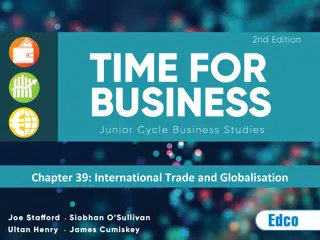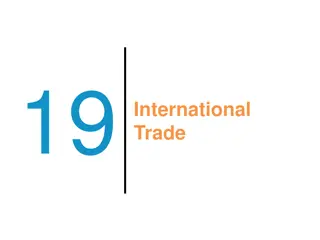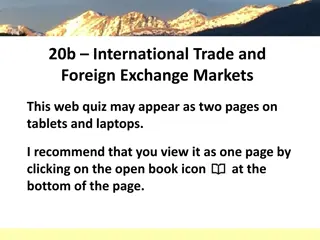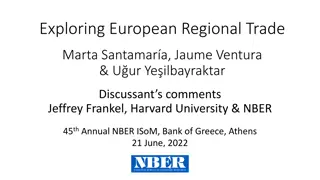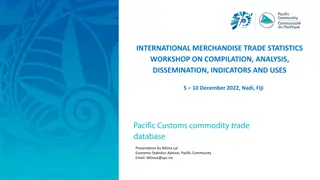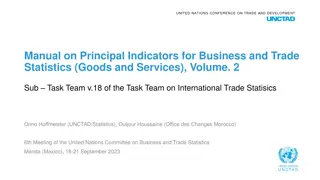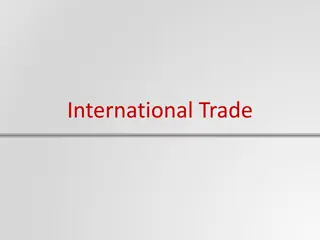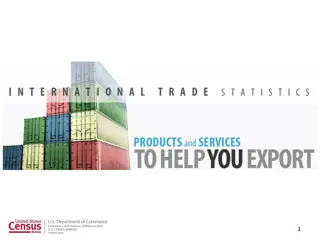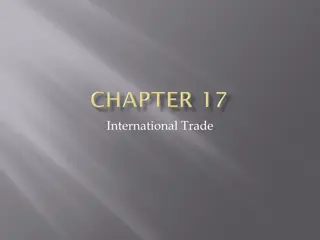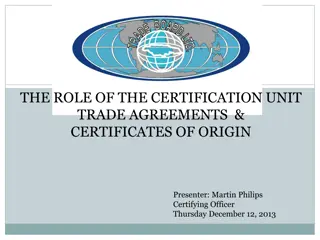Task Team on International Trade Statistics Progress Overview
The Secretariat of the Task Team on International Trade Statistics, under the United Nations Committee of Experts on Business and Trade Statistics, is actively involved in revising manuals on international trade statistics. Established in 2021, the team focuses on enhancing the integration between trade and business statistics, capacity building, and leadership representation. Their mandates include revising IMTS 2010 and MSITS 2010 in collaboration with stakeholders and coordinating work programs with other entities. The team's working structure involves co-leaders from Portugal and Morocco, reflecting a commitment to improving international trade statistics worldwide.
Download Presentation

Please find below an Image/Link to download the presentation.
The content on the website is provided AS IS for your information and personal use only. It may not be sold, licensed, or shared on other websites without obtaining consent from the author.If you encounter any issues during the download, it is possible that the publisher has removed the file from their server.
You are allowed to download the files provided on this website for personal or commercial use, subject to the condition that they are used lawfully. All files are the property of their respective owners.
The content on the website is provided AS IS for your information and personal use only. It may not be sold, licensed, or shared on other websites without obtaining consent from the author.
E N D
Presentation Transcript
Revision of Manuals on International Trade Statistics Overview and progress Secretariat of the Task Team on International Trade Statistics United Nations Committee of Experts on Business and Trade Statistics Statistics Division, Department of Economic and Social Affairs Email: tradestat@un.org ------------------------------------------------------------------------------------------------------------------------------ Presentation at the Central American Regional Workshop on International Merchandise Trade Statistics (IMTS), 22-25 October 2023
Manuals on international trade statistics
Background - 52nd Statistical Commission (2021) Statistical Commission decision 2021 52/107: Endorsed revising IMTS 2010 and MSITS 2010, while ensuring consistency with the update of other statistical standards, such as the SNA and BOP; Welcomed the creation of a new task team for the revision of the trade- related standards.
Task Team on International Trade Statistics UN Committee of Experts on Business and Trade Statistics Established in 2021: First meeting in October 2021 Monthly meetings Priorities: Revising the international trade statistics manuals Integration between trade and business statistics Cross-cutting topics (e.g., GVC, digital trade) Capacity-building (maturity model, trade data tools) Leadership, broad representation: TT-ITS is led by Morocco and Portugal Worldwide representations
Mandates of the Task Team on International Trade Statistics (TT ITS) Revise trade statistics manual: IMTS 2010 and MSITS 2010 in collaboration with other stakeholders Enhance the integration between trade and business statistics Promote capacity building activities and collaborate on ongoing technical assistance projects Coordinate the Integration of work program with other entities
Working structure: Co-leaders: Portugal and Morocco
Brief overview of activities (2022/2023) Revision of trade statistics manuals (IMTS and MSITS) Took stock of revisions to SNA and BPM and reviewed their impacts Drafting various guidance notes based on the list of defined research topics (through global consultation) Prepared and consulted the outlines Drafting the handbook on integrating business and trade statistics Drafting the 2ndvolume of Manual on Principal Indicators on Business and Trade Statistics Contributing to Gender mainstreaming in Business and Trade Statistics with IAEG-GS Development of the trade data tools
8 Revision of trade statistics manuals (IMTS and MSITS) Timelines Research agenda Topics in the 1stround global consultations (May 2023) Outcomes of the 1st Global Consultation Plan for the 2nd global consultations
Timeline - General Implementation: Undertake capacity building activities including the development of the compilation guides for IMTS 202X and MSITS 202X Preparations to establish the Task Team and identification of its members Drafting IMTS 202X and MSITS 202X including country consultation on the new 2021 2022 2023 2020 Development of guidance notes, country consultation on research topics, and testing taking in to account the progress made by the update of BPM and SNA Adoption of IMTS 202X and MSITS 202X by UN Statistical Commission The timeline was discussed in the last UNCEBTS meeting Committee requested to prioritize quality over the initial deadlines The task team will continue reviewing the deadlines, considering the progress of the completion of GNs in the 2nd Global Consultation, the availability of the drafters/editors, and the completion of the final draft text from BPM and SNA revisions 9
Research Agenda: Vertical and Horizontal integration Horizontal integration Upstream harmonizationofITSwith macroeconomic statistical frameworks, including BPM and SNA Downstream integration with the variousdata sources, including customs, administrative and survey data Vertical integration Globalization Digitalization Well-being Sustainability
Research Agenda: Vertical v.1 Scope of IMTS and SITS v.2 Impact of the BPM updates v.3 Bilateral trade asymmetry (goods and services) v.4 Informal Cross Border Trade (Goods And Services) v.5 Recording Principle Change Of Ownership Instead Of Cross-Border For Selected Commodities (Goods) v.6 Trade System Improved Coverage By Implementing General Trade System Exclusively (Goods) v.7 Valuation Utilizing Invoice Value In Addition To CIF, FOB (Goods) v.8 Price And Volume Measurement (Goods And Services) v.9 Factoryless Goods Producers And Merchanting (Goods) v.10 Measurement Of Modes Of Supply (Services) v.11 SITS Classifications EBOPS (Services) v.12 Trade Flow, Nature Of Transactions And Customs Procedure Codes (Goods) v.13 Valuation on specific transactions/products (Goods and Services) v.14 Alternative data sources high-frequency data sources (Goods and Services) V.15 Upgrading SDMX-IMTS to Technical Specification version 3.0 (Goods) v.16 Clarification on Cultural Products Resulting From Creative Industries (Goods and Services) v.17 Revision of the Standard International Trade Classification (SITC) (Goods) v.18 Indicators on Trade Statistics (Goods and Services) Guidance Notes in the first global consultation Dedicated handbook
Research Agenda: Horizontal h.1 Digital Trade Including Conceptual Framework, Price And Volume Measurement (Goods And Services) h.2 Global Value Chains (Goods And Services) h.3 Linking Trade And Business Statistics (Goods And Services) h.4 Impact Of Trade On Environment And Sustainability (Goods And Services) h.5 Impact Of Trade On Well-Bering, Labor, Gender And Productivity (Goods And Services) h.6 Foreign Affiliates Statistics (FATS) (Goods And Services) h.7 Classification: BEC Rev.5, Business Functions (Goods And Services) h.8 Impact Of ISIC And CPC Revisions (Goods And Services) Guidance Notes in the first global consultation Dedicated handbook
So far (as of October 2023) Update of related standards Macroeconomic frameworks SNA (2025) BPM (2025) Classifications ISIC (2023) CPC (2024) HS (2027) Conceptual issues The first round of global consultations Emerging proposals for updating the manuals IMTS and MSITS: manual outlines
Topics for 1stglobal consultations [Topic #1: Definition, scope and delineation of goods and services] [Topic #2: Comprehensive review on the impact of BPM 6 updates] [Topic #3: Definition and delineation of Informal Cross Border Trade (ICBT)] [Topic #4: Valuation utilizing invoice value in addition to CIF and FOB] [Topic #5: Measurement of digital trade] [Topic #6: Linking of trade and business statistics] [Topic #7: Change of ownership in IMTS v. BOP] [Topic #8: Clarification on cultural products resulting from creative industries] [Topic #9: Impact of trade on wellbeing, labour, and productivity] [Topic #10: Draft outlines for IMTS and MSITS] [Topic #11: Draft outline for the Handbook on Integrating Business and Trade Statistics (HIBTS)] 14
[Topic #1: Definition, scope and delineation of goods and services] Seeks to clarify the distinction between services and goods regarding their delineation and recording in trade in goods or services Proposes emphasizing the distinction between how products are defined and how they are recorded, expanding the MSITS 2010 definition of services to explicitly cover knowledge capturing products that are services, and providing additional examples to better operationalize the definition of services Regarding goods printed/manufactured using an additive manufacturing process (e.g.,3-D printing) acquired from abroad Also recommends that non-fungible tokens (NFTs) that are classified as either consumption or assets according to SNA/BPM GN DZ.10 would be recorded as services Furthermore, for consistency in classification of NFTs that convey no ownership rights as services in the case that they transition to valuables, this Note recommends that the 2008 SNA para. 10.13 definition of valuables be generalized to define valuables as products rather than goods 15
[Topic #2: Comprehensive review on the impact of BPM 6 updates] Sub Task Team on GNV.2 coordinating with the whole Task Team on incorporating BPM updates into trade manuals Ensure that all of the updates to BPM6 relevant to trade are incorporated into trade manuals Output a table for the appendix(ices) of the trade manual(s) to identify all BPM6 updates that impact IMTS and/or MSITS 16
[Topic #3: Definition and delineation of Informal Cross Border Trade (ICBT)] Defines the informal cross border trade (ICBT) both in IMTS and MSITS that can be consistent with country best practices and the informal economy conceptual framework as described by the guidance note by the joint SNA/BPM updates (IE.1) Proposed definition based on delineating transactions that are not covered by formal arrangements (in law or in practice). Working definition Informal cross-border trade refers to imports and exports, by informal economic units, of legal goods and services, which do not comply with the regulatory framework and other procedures set by the government, and often go unrecorded into official national statistics of the trading countries 17
[Topic #4: Valuation utilizing invoice value in addition to CIF and FOB] Using invoice values as the valuation methods for imports and exports is conceptually more consistent with the general conceptual principle of recording output at basic prices in National Accounts (G.1) GNV.7 discusses the options for IMTS to record the invoice value in addition to CIF, FOB CIF-FOB valuation implies a valuation at the point where the good crosses the border of the reporting country and is, therefore, in line with the cross-border principle applied in IMTS While CIF-FOB, therefore, should remain the valuation method used for IMTS disseminations, this note proposes encouraging countries also to collect invoice values to facilitate the transition for BPM and SNA Freight and insurance services Importer v. exporter split Record on transaction basis Different valuation methods and their relevance for the different statistics be clarified in IMTS 18
[Topic #5: Measurement of digital trade] The Handbook on Measuring Digital Trade (IMF, OECD, UNCTAD and WTO, forthcoming) sets up the statistical definition of digital trade and establishes a conceptual framework for measurement TT-ITS recommends the conceptual and measurement framework of digital trade be included in the updated MSITS and IMTS, with a short common chapter summarizing the most important concepts and presenting the reporting template for digital trade. 19
[Topic #6: Linking of trade and business statistic] Issues include concepts, data sources, and technical considerations for producing statistics from linking trade and business data (for goods and services) GNH.3 highlights the relevance of Microdata linking (MDL) for producing new statistics by effectively using existing data sets without increasing the response burden on respondents It recommends highlighting in trade manuals the importance of identifying the statistical unit (legal/enterprises/establishment) and the difficulties some countries may face. The GN includes alternatives for countries with different statistical infrastructures (e.g., structural business statistics surveys) without an SBR and/or a unique identifier in place for linking trade and business statistics. It also emphasizes the importance of indicators on quality 20
[Topic #7: Change of ownership in IMTS v. BOP] GNV.5 reviews and elaborates on the commodities under the principle of change of ownership based on countries' experiences Keep cross-border physical movement as the basic recording principle in IMTS Review the list of goods to be compiled based on change of ownership as an exception to the general cross-border principle Encourage countries with a major involvement in global production chains to publish supplementary (non-mandatory) statistical products, including disaggregated data, say by Statistical Procedure Codes or Nature of transactions help users understand and quantify the conceptual differences between IMTS and SITS/BoP figures and finding the figures most relevant to their purposes. 21
[Topic #8: Clarification on cultural products resulting from creative industries] GNV.16 clarifies conceptual issues related to cultural products resulting from cultural and creative industries. It recommends adding new categories on culture/creative trade to the travel in EBOPS. The identification of handmade cultural goods could be achieved by countries by expanding their national customs classification at a further level of disaggregation. Furthermore, GNV.16 gives practical guidance on compiling trade data for assessing international trade in cultural and creative goods and services 22
[Topic #9: Impact of trade on wellbeing, labour, and productivity] Important links with the 2030 Agenda Engine for inclusive economic growth and poverty reduction; Positive effects on productivity Impacts economic, environmental, and social wellbeing through its distributional effects and health impacts related to prices and types of goods and services traded Trade can also exacerbate existing inequalities, including income and other inequalities by sex and ethnicity. GNH.5 proposes productivity related indicators; labour and wage related indicators; wellbeing and gender inequalities related indicators Furthermore, the GN also considers clarifying definitions for the Volume 2 of the Manual on the Principal Indicators on Business and Trade Statistics: exporter, importer, trader, two-way trader, domestic enterprise, and multinational enterprise (MNE) It is recommended that Volume 2 of the Manual on the Principal Indicators on Business and Trade Statistics mainstream data by sex, also by gender (where possible) 23
[Topic #10: Draft outlines for IMTS and MSITS] Modest changes except for (a) Better alignment between IMTS and MSITS (b) Introducing common titles and a few new chapters/sections for IMTS and MSITS (c) Upgrading a few sections to chapter level to enhance their prominence or relation with other sections/chapters: https://unstats.un.org/wiki/download/attachments/160137218/Draft%20outline%20IMTS%20and%20MSITS.pdf?version=1&modificationDate=1682564687314&api=v2 24
Outcomes of the 1st Global Consultation: Results of global consultations on topics regarding the revision of trade manuals. There was a good response rates from all the regions. Many responding countries agree with the proposals. It was highlighted to thoroughly consider response details regarding specific topics of interest to specific regions and where significant responses express no opinion. Examples that require thorough consideration include topics on the definition and delineation of ICBT, clarification on cultural products resulting from creative industries, and the impact of trade on wellbeing, labour, and productivity. It may not have been clear that the global consultations on the GNs focused on conceptual issues because many respondents requested the inclusion of country practices The country practices will be included in the forthcoming Compilers' Guide.
Plan for the 2nd global consultations Consolidated recommendations Annotated manual outlines (IMTS, MSITS) V3 Bilateral trade asymmetry V8 Price and volume measurement V9 Factoryless goods producers and merchanting V10 Measurement of Modes of Supply V11 SITS Classifications EBOPS V12 Trade flow, nature of transaction and Customs Procedure Codes V13 Valuation on specific transactions/products (in progress)
Plan for the 2nd global consultations V14 Alternative data sources high-frequency data sources V15 Upgrading SDMX-IMTS to technical specifications version 3.0 H2 Global Value Chains (existing handbook) H4 Impact of trade on environment and sustainability H6 Foreign Affiliates Statistics (no need for a GN explanation) H7 Classification: BEC Rev.5, Business Functions H8 Impact on ISIC and CPC revisions (waiting for other inputs)
Thank you 28


